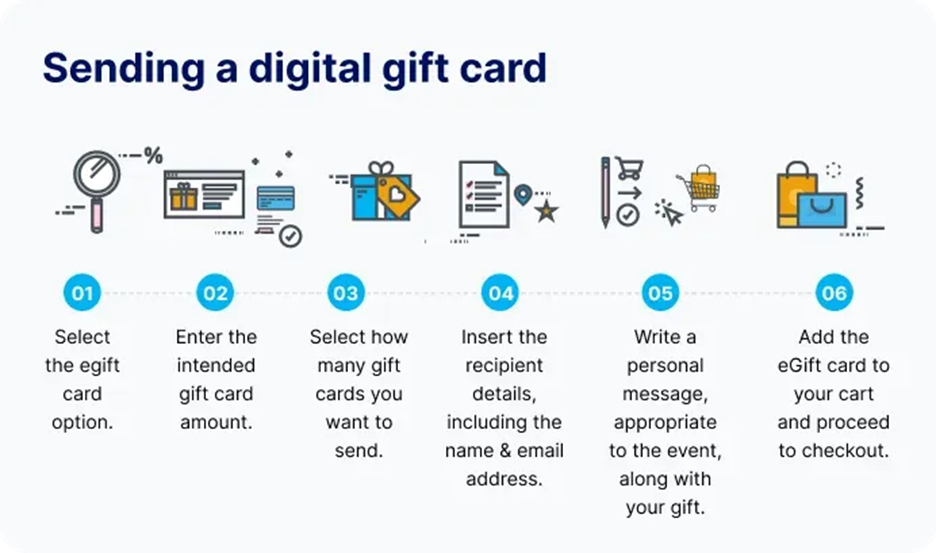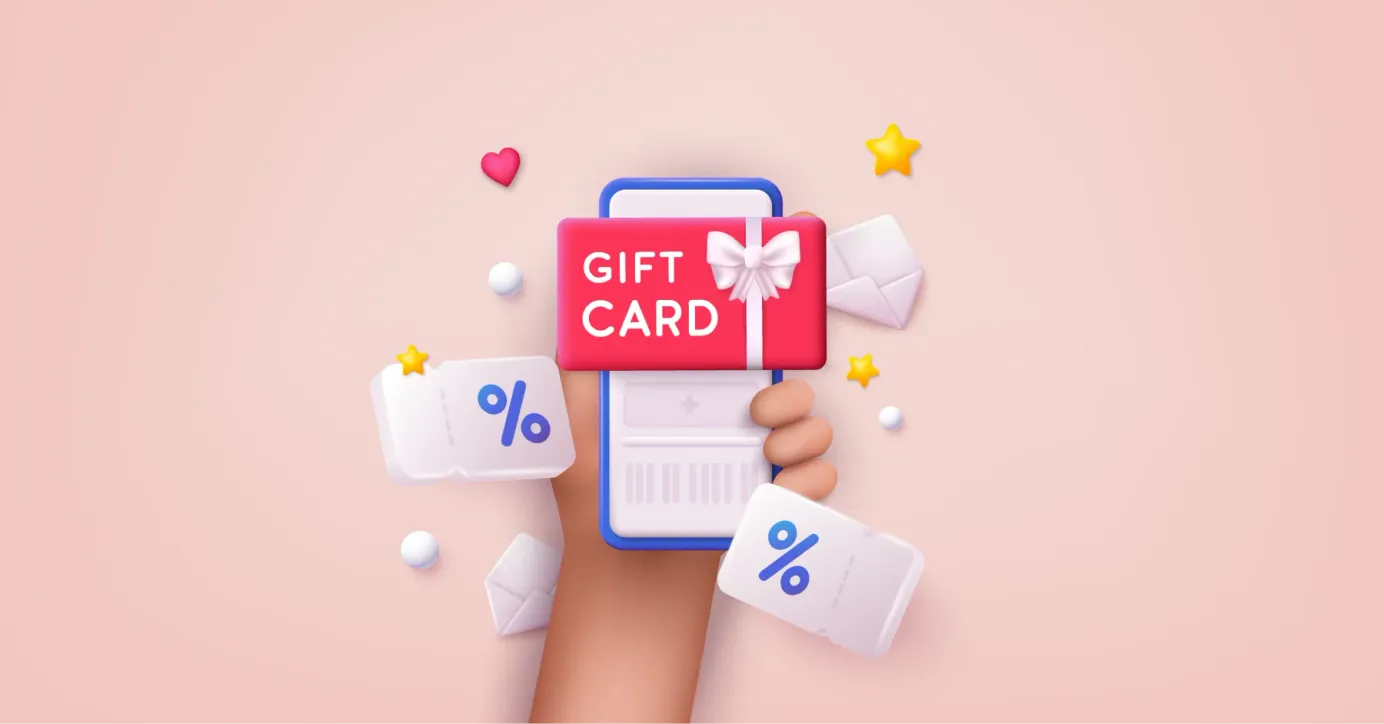Physical vs Digital Gift Cards: A Thorough Competitive Analysis
Physical vs digital gift cards—which works best for modern gifting? This blog compares both on delivery speed, cost, personalization, scalability, and ease of use to help you choose the perfect option for employee rewards or customer gifting.
On this page
From a cave-dwelling man giving a small shiny piece of unique rock to a woman to the ultra-modern modus operandi of digital presents, the tradition of gifting—the most beautiful expression of displaying gratitude, love, and respect to other human beings—has traversed a long path.
And like a rule of concomitance, corporate gifting hasn't been left untouched by it. In fact, one needs to acquire special blindness to ignore the growing sway that digital gifts have on the current world, both personal and professional.
In this blog, we will thoroughly explore the differences between physical and digital gift cards and how digital gift cards outperforms physical ones.
What is a physical gift card?
Physical gift cards are tangible, preloaded cards—usually made of plastic or thick paper—that carry a specific monetary value and can be used as a form of payment at designated retail stores, restaurants, or online platforms.
They often feature a barcode, magnetic strip, or unique code for redemption and are commonly used for personal or corporate gifting, offering recipients the flexibility to choose what they want to buy.
➼ The global gift card market is projected to grow from $1.09 trillion in 2023 to $1.29 trillion in 2024v, reflecting a compound annual growth rate (CAGR) of 18.4%. This surge is attributed to the rise in e-commerce, increased disposable income, and greater adoption of mobile payments.
➼ A significant trend in 2024 is the rapid rise of digital and e-gift cards. As digital payments and e-commerce grow, more consumers are opting for the convenience of virtual gift cards, which can be delivered instantly and are easier to use via mobile apps and online platforms.
➼ The global digital gift card market size reached USD 453.4 billion in 2024 and is expected to grow at a CAGR of 13.32% to reach USD 1,531.5 billion by 2033. This growth is driven by the expanding e-commerce sector and the increasing adoption of digital gift cards for their convenience and flexibility.
What is a digital gift card?
A digital gift card, also known as an electronic, virtual, or mobile gift card, is a virtual gift option that enables one to redeem the gift of choice on electronic platforms. It can be in the form of codes or reward-based links and sent to the recipient via phone or email.
A digital gift card works just like regular gift cards. Depending on the card merchandiser, you can use this code online and in the store. Note that it's a valid alternative to cash.
Apart from the ease of sending and receiving, digital gift cards bring momentous value to both the sender (companies) and receivers (employees, customers, partners.) The following value attributes are just the tip of the iceberg.
Physical vs. digital gift cards: The difference
When you compare this mind-boggling acceptance and growth of digital presents to physical gift cards — a steady 6%, even the slightest doubt about the former's supreme rein will vanish as quickly as vapor. What is making digital gift cards so popular among corporates and non-corporates alike?
Here is a short comparison:
|
Feature |
Physical Gift Cards |
Digital Gift Cards |
|
Delivery Time |
Physical gift cards can take days or even
weeks to reach the recipient due to printing, packaging, and courier delays. |
Delivered instantly or scheduled for a
specific time, offering speed and flexibility. |
|
Time Consumption |
High—managing inventory, packaging,
dispatch, and tracking takes significant effort and coordination. |
Low—digital gifts can be sent within
minutes, even to large groups, using automation. |
|
Redemption Method |
The recipient needs to visit a store or
enter the card manually, which can be cumbersome. |
Recipients can redeem instantly online or
in-store using the code, link or points. |
|
Gift Choice Limitations |
Often restricted to a particular brand or
store, which may not suit every recipient. |
Offers access to a wide
catalog—recipients can choose gifts that suit theirii5 preferences. |
|
Customization Options |
Limited personalization—usually just the
printed message or card design. |
Extensive options—custom messages,
themes, values, and branding for events or occasions. |
|
Risk of Loss/Damage |
Cards can be lost, stolen, or damaged
before use, leading to customer dissatisfaction. |
Minimal risk—digital gifts are stored in
email, SMS, or apps and can be reissued. |
|
Environmental Impact |
Involves plastic, paper, and carbon
emissions from logistics—less eco-friendly. |
Eco-conscious—eliminates the need for
printing, packaging, and delivery vehicles. |
|
Scalability |
Hard to scale—bulk ordering, warehousing,
and shipping logistics make mass gifting slow. |
Highly scalable—perfect for large teams,
global customers, or survey incentives. |
|
Cost of Distribution |
Includes printing, packaging, shipping,
and handling—adds up quickly. |
Very low—most platforms only charge for
the value of the gift and optional platform fees. |
|
Integration with Digital Tools |
Limited or no ability to plug into HR,
CRM, or loyalty platforms. |
Seamlessly integrates with CRMs, HRMS,
rewards, and loyalty systems via APIs. |
|
Tracking & Reporting |
Manual tracking is required, which
increases errors and slows down reconciliation. |
Digital tools provide real-time tracking,
redemption reports, and performance insights. |
|
Ideal Use Case |
Great for in-person events, luxury
presentations, or traditional corporate gifting. |
Ideal for remote workforces, real-time
recognition, and global incentive programs. |
Why are digital gifts better than physical gifts?
Here are ten reasons that justify why digital gifts are better than physical gifts:
1. Enormous scope for personalization
The perceived value of the gift generates deeply from the personal connection that it evokes, and countless studies staunchly support it.
- Consumer demand for personalization: Deloitte's 2024 Consumer Loyalty Survey indicates that consumers increasingly seek personalized, flexible, and digital-centric loyalty programs.
- Personalization enhances customer loyalty: A report by Forrester reveals that consumers value personalized experiences that are relevant and valuable, suggesting that personalization efforts can significantly impact customer loyalty.
- Personalization as a competitive advantage: Gartner's insights suggest that companies leveraging consumer trends to create personalized and engaging customer experiences see higher customer satisfaction and loyalty.
With the freedom to set their denominations and not having to stick to a predetermined amount, modify all the elements of the gift card from the face to a ceremonial bowtie to “unwrap” the card, senders can achieve the most conceivable level of personalization with virtual gifts.
2. Instant gratification renders geographical barriers insignificant
Digital gift cards are sent to the receiver through SMS, email, or specialized gifting apps. It guarantees instant, immediate delivery — making digital gift cards the best choice if your employees or clients are living in a different country or continent.
Note that it is not just saving you from the delays that cross-boundary issues might trigger. You are also weeding out the need for your employees and clients to go to the store and stand in long serpentine queues to redeem the gift.
All they need is a few clicks, and the gift of their choice is on its way. Also, digital gifting platforms like Plum offer multilingual services, letting you craft a personalized gift and message without the fear of it getting mistranslated.
3. Low on cost, high on effect prospect

Imagine sending a thousand physical gifts to thousands of employees/clients located at different locations?
Starting from acquiring gifts that suit each persona to putting it in inventory; and from ensuring the right last-mile delivery through third-party delivery partners to handling the return of gifts in case the address is wrong or non-updated, the cost is written everywhere.
The size of recipients, on the contrary, is an ineffectual aspect for the sender of digital presents. The sender just needs to send codes or links to the recipients, costing zilch to the company. Similarly, it’s much cheaper than replacing the wrong email id in the system than to face the extra ride due to the wrong physical address.
4. Idea for last-minute gifts

However immaculately planned your corporate gifting program with all the recipients' names and usual suspects of events is, a need for last-minute gifts can prop up from blue.
Your sales team might have ballparked a handsome sum from a not-so-bright warm lead, or your esteemed client’s company might have been at the podium for the reception of a glorious business award.
These achievements are, by all stretches of the imagination, worthy of a gift from you. But the caveat is that you hadn’t roped in this possibility in your gifting planning, putting you on the verge of missing out on a really deserving gifting opportunity.
Digital gift cards are the actual savior, in the rightest possible meaning of the word, in this crisis-like situation. Where traditional gift cards get delivered within 6 to 8 days, digital gift cards land in the digital premises of receivers within 24 hours.
Also, through automation, they steer you out of the disaster of missing out on key gift-worthy events.
5. No possibility of misplacing them

One of the best things about digital gift cards is they are unlosable. They stay permanently in your email and message. It’s a great relief to your employees/clients who are worried about misplacing their cards or cash.
Note that 40% of 18 to 29-year-olds agreed to losing their physical gift cards right before they wanted to spend it.
"Electronic gift cards are definitely harder to lose. It can exist in your email, as opposed to a piece of plastic that may or may not make it into your wallet."
6. Easy to scale up

Since most digital gift platforms are API-based, adding a whole new category of gifts and their respective vendors is less time-consuming and money minting. The developer and system technicians can bring in integration within a few days, reducing your go-to-market time.
The greatest advantage of this time efficiency is it lets you grasp the pulse of gifting trends, what your employees/customers want as a corporate gift, and make changes in your gifts profile. This makes your gifting endeavor more relevant and highly desirable to the recipients.
7. Lower risk of scams and misuse

As the information on digital gift cards gets generated at the time of purchase and sent directly to you or the recipient, you are less likely to be a victim of popular gift card scams, namely gift card skimming.
Moreover, you pay only for the gifts that have been redeemed - and all these transactions are available to you in real time. If you notice any discrepancy of any type, you can connect with the digital gift platform’s customer service and get the doubts ironed out.
8. They are eco-friendly
Where climate change is becoming a reality rather than fiction, and natural catastrophes are hitting us with the regularity of a pendulum, preserving natural resources is key to our planet's sustenance.
Physical gift cards are antithetical to it since:
- They demand cutting down valuable trees for the creation of a plastic card, which functions as a one-time voucher.
- Shipping gifts physically pollutes the world compared to their digital counterparts.
- Digital gifts cards don’t have to be printed on plastic or paper, avoiding sinful wastage of natural resources.
With a microscopic consideration of these climate requirements, the benefits guaranteed by digital gift cards can’t be highlighted more pinpointedly.
How to send a digital gift card
Sending a digital gift card, under any circumstances, wouldn’t take more than a minute. Here are the steps to send an egift card.

To send a digital gift card, begin by choosing a gift card from a trusted platform that offers variety and convenience. Select the brand and value, add a personalized message, and enter the recipient’s email or mobile number. You can send it instantly or schedule it for a later date. It’s a quick, thoughtful, and hassle-free way to show appreciation.
Xoxoday Plum empowers you with access to a vast global catalog of digital gift cards, along with seamless delivery options and full control over personalization, tracking, and reporting—making it the perfect platform for effortless and impactful gifting at scale.
The Smart Shift: How digital rewards drive real results
Kantar, a leading global data insights and consultancy firm, faced a familiar challenge—how to motivate survey respondents at scale while streamlining the reward process. By switching to digital gift vouchers by Xoxoday Plum, they gave participants the freedom to choose from over 21,000+ reward options across 100 countries. In just three months, they successfully delivered rewards worth over $3.32 million, all while eliminating the inefficiencies of manual reward distribution.
Kantar’s success story is a clear indicator of where corporate gifting is headed—toward digital, scalable, and personalized experiences.
This shift is not just practical—it’s strategic. Whether you’re managing survey incentives, customer gifting, or employee recognition, Plum offers you a powerful digital reward platform that combines global reach with seamless automation. Customize rewards, simplify workflows, and elevate every interaction—without the friction of logistics or manual processes.
Ready to transform your reward strategy like Kantar did? Schedule a free demo and we will get you started!


















